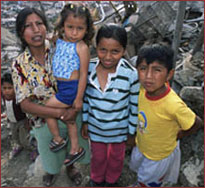
In 2012, the World Bank updated its estimates of global poverty rates. The results for the latest years studied — 2005 to 2008 — indicated that the percentage of people living below the poverty line declined for all six regions studied. This was the first decline over a three-year period since 1981.
The 2005-2008 findings are based on 850 surveys compiled from 130 developing countries; the surveys included 1.23 million households and provided a statistical snapshot of some 90% of the population of the developing world. For the purposes of the estimates, those unable to spend $1.25 a day on consumption (after adjusting for inflation and exchange rates) were classified as poor.
The findings of the World Bank’s “Global Poverty Estimate” include:
- The number of people living below the $1.25-a-day poverty line declined from 1.94 billion (52% of the population of the developing world) in 1981 to 1.29 billion (22%) in 2008, a 33.5% drop. Those living on less than $2 a day also declined, from 2.59 billion total in 1981 to 2.47 billion people in 2008, a drop of 4.6%.
- East Asia saw the most dramatic declines in poverty rates, from 77% of its population in 1981 to 14% in 2008. The Middle East and North Africa region saw poverty fall from 9.6% in 1981 to 2.7% in 2008. Over the same time period, South Asia saw its population under the poverty measure decline from 61% to 36%.
- China’s efforts to alleviate poverty accounted for a significant amount of global reduction, with its rate going from 84% in 1981 to 13.1% in 2008. On average, total poverty in the developing world declined by 1.05 percentage points per year between 2005 and 2008; when China is excluded, the reduction is 0.54 percentage points per year.
- For the first time since 1981, less than half of the population of sub-Saharan Africa lived below the $1.25-a-day poverty line. Between 1981 and 2008, the region’s population living below the poverty line declined 4 percentage points, to 47%.
- By 2010, using the $1.25 a day poverty measure, developing countries had achieved the United Nations Millennium Development Goal of halving the incidence of poverty rates in 1990. Eastern Europe and Central Asia reached this goal in 2008.
- Although poverty rates in developing countries (excluding China) declined from 41% to 25% between 1981 and 2008, population growth has generally kept up with poverty reduction: “At the current rate of progress there will still be around 1 billion people living below $1.25 per day in 2015.”
- While the number of people living on between $1.25 and $2 a day has nearly doubled — from 648 million in 1981 to 1.18 billion in 2008 — the rate of those earning more than $2 a day has slowed. Those living on between $1.25 and $2 a day remain particularly vulnerable, as they are only covering their most basic expenses and are subject to the risk of slipping under the $1.25 line should they face an adverse income shock.
- Nearly 649 million of those who moved above the $1.25 poverty line had a standard of living that was nevertheless below what would be defined as “poor” in middle-income developing countries and far below that of rich countries.
The report notes that basing poverty calculations solely on consumption expenditures fails to capture spending on health, education and other indicators. These should be considered together with consumption-based poverty measures to gain a more holistic picture of the degree of poverty experienced, they suggest.
Tags: poverty, Asia
